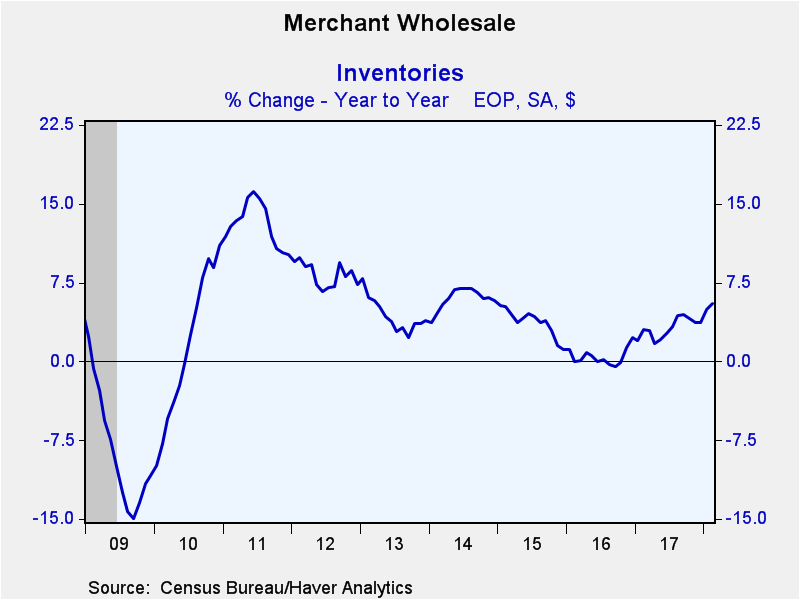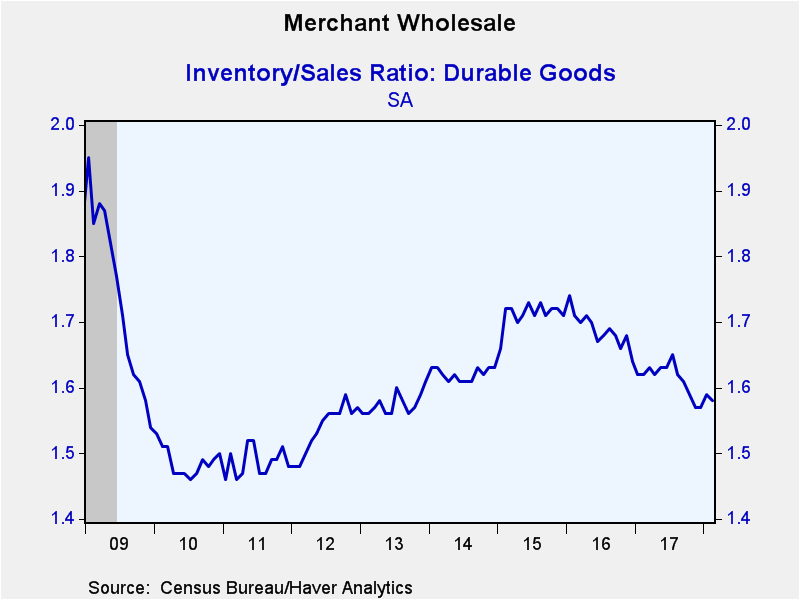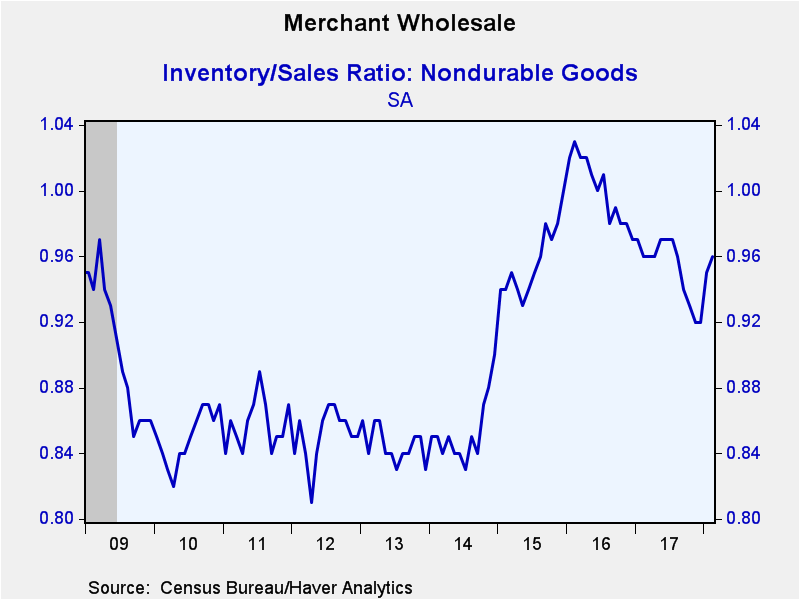 Global| Apr 10 2018
Global| Apr 10 2018U.S. Wholesale Inventories Rise and Sales Rebound in February
by:Sandy Batten
|in:Economy in Brief
Summary
Wholesale trade inventories increased 1.0% m/m (5.5% y/y) in February following an upwardly revised 0.9% m/m gain in January. The February rise was down slightly from the 1.1% m/m increase in the advance report released on March 28 [...]
Wholesale trade inventories increased 1.0% m/m (5.5% y/y) in February following an upwardly revised 0.9% m/m gain in January. The February rise was down slightly from the 1.1% m/m increase in the advance report released on March 28 and also was slightly below market expectations.
Durable goods inventories increased 1.1% m/m (6.1% y/y) in February following a modest 0.2% m/m rise in January. This was the largest monthly increase in durable goods inventories since December 2013. A 2.8% m/m (-0.1% y/y) rise in computer and peripherals inventories led the February increase in durables inventories though the increase was widely spread. Inventories of nondurable goods also increased in February, rising 0.8% m/m (4.6% y/y) after a 2.0% m/m jump in January. The February slowdown was due mostly to a turn in petroleum inventories which fell 3.7% m/m in February following a 3.3% jump in January. The biggest gain in nondurable inventories in February was a 5.7% m/m jump in inventories of farm product raw materials.
Sales at the wholesale level rebounded in February, rising 1.0% m/m (6.8% y/y) after a downwardly revised 1.5% m/m decline in January (initially reported as -1.1%). A 0.5% m/m rise for February had been expected in the Action Economics Forecast Survey.
Durable goods sales jumped 1.7% m/m (8.6% y/y) in February, more than offsetting a 1.2% m/m decline in January. The increases were widespread across categories with leaders being a 4.5% m/m gain in furniture sales and a 4.4% m/m increase in sales of metals and minerals excluding petroleum. Nondurable goods sales rose a more modest 0.4% m/m (5.2% y/y) in February following a 1.7% m/m drop in January. Apparel sales surged 5.0% m/m and sales of farm product raw materials increased 3.3% m/m. In contrast, drug sales fell 2.4% m/m.
The inventory-to-sales ratio at the wholesale level was unchanged at 1.26 in February, its highest level since August. It remained, however, well below its most recent high of 1.36 in February 2016.
The I/S ratio for durable goods edged down to 1.58 in February from 1.59 in January. It remains was well below its most recent peak of 1.74 in January 2016. The furniture I/S retreated to 1.70 in February after having jumped to 1.75 in January, its highest reading since April 2011. The machinery and equipment I/S continued its general downtrend, falling to 2.72 in February from 2.78 in January. The I/S ratio for nondurable goods edged up to 0.96 in February from 0.95 in January. Only three of the nine major categories experienced increases in February, but these were sufficiently significant to pull up the overall measure.
The wholesale trade figures are available in Haver's USECON database. The Action Economic Survey results are contained in AS1REPNA.
| Wholesale Sector - NAICS Classification (%) | Feb | Jan | Dec | Y/Y | 2017 | 2016 | 2015 |
|---|---|---|---|---|---|---|---|
| Inventories | 1.0 | 0.9 | 0.7 | 5.5 | 3.6 | 2.6 | 1.1 |
| Sales | 1.0 | -1.5 | 0.8 | 6.8 | 7.6 | -0.4 | -4.9 |
| I/S Ratio | 1.26 | 1.26 | 1.23 | 1.28 (Feb'17) | 1.27 | 1.33 | 1.32 |
Sandy Batten
AuthorMore in Author Profile »Sandy Batten has more than 30 years of experience analyzing industrial economies and financial markets and a wide range of experience across the financial services sector, government, and academia. Before joining Haver Analytics, Sandy was a Vice President and Senior Economist at Citibank; Senior Credit Market Analyst at CDC Investment Management, Managing Director at Bear Stearns, and Executive Director at JPMorgan. In 2008, Sandy was named the most accurate US forecaster by the National Association for Business Economics. He is a member of the New York Forecasters Club, NABE, and the American Economic Association. Prior to his time in the financial services sector, Sandy was a Research Officer at the Federal Reserve Bank of St. Louis, Senior Staff Economist on the President’s Council of Economic Advisors, Deputy Assistant Secretary for Economic Policy at the US Treasury, and Economist at the International Monetary Fund. Sandy has taught economics at St. Louis University, Denison University, and Muskingun College. He has published numerous peer-reviewed articles in a wide range of academic publications. He has a B.A. in economics from the University of Richmond and a M.A. and Ph.D. in economics from The Ohio State University.










